By: Ann Windnagel, National Snow and Ice Data Center and Jackie Richter-Menge, Cold Regions Research and Engineering Laboratory
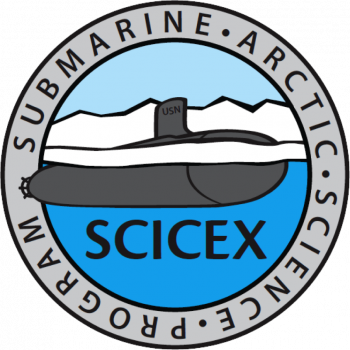
The Arctic is a harsh environment for performing scientific research and there remain significant logistical challenges when it comes to sampling the Arctic Ocean. Satellites have helped to increase our understanding of this variable region of the Earth by providing surface measurements and sea ice extents. However, what about measurements under the sea ice? How can we synoptically collect data about Arctic Ocean bathymetry, sea ice draft, hydrography, and water chemistry? This is where U.S. Navy (USN) nuclear submarines come into play. They offer a unique observational platform because, unlike surface ships, they can operate and take measurements regardless of sea ice cover, weather conditions, and time of year.
With the end of the Cold War, the U.S. submarine fleet suddenly found itself with fewer operational tasks. A quick thinking retired U.S. Navy Captain, George Newton, saw the possibilities immediately (see sidebar: A Labor of Love Brings Together Civilian Scientists and the U.S. Navy). Would it be possible to use these submarines to collect scientific data? Newton thought so, and worked tirelessly to bring together a unique collaboration between military and civilian communities. In 1993, his hard work paid off when the first feasibility test of this idea came to reality as five civilian scientists joined the crew of the USS Pargo for 19 days to utilize this unique platform to gather data about the Arctic Ocean. The test was a success, and the Submarine Arctic Science Program (SCICEX) was launched.
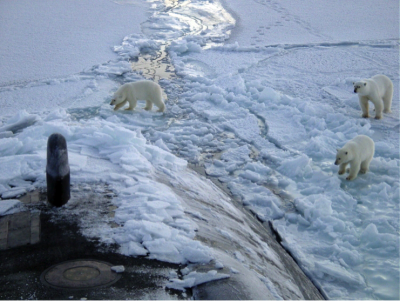
The USN, the Office of Naval Research (ONR), the National Science Foundation (NSF), the National Oceanic and Atmospheric Administration (NOAA), and the U.S. Geological Survey (USGS) signed an agreement to facilitate five more such dedicated missions between 1995 and 1999. During this time, the submarines were modified with temporary alterations of scientific instruments including downward looking sonars to collect bathymetric data and modified valves in the torpedo room for collecting through-hull water samples. However, many of the submarine systems designed for safety could also be used to gather data for scientific studies. For instance, the upward looking sonar provide measurements of sea ice draft, and sail-mounted sensors routinely collect information on water conductivity and temperature.
Beginning with the proof-of-concept mission in 1993, the SCICEX program has been collecting unique data on Arctic Ocean bathymetry; sea ice draft; ocean nutrients; and ocean hydrography in the form of conductivity, temperature, and density (CTD) ever since.
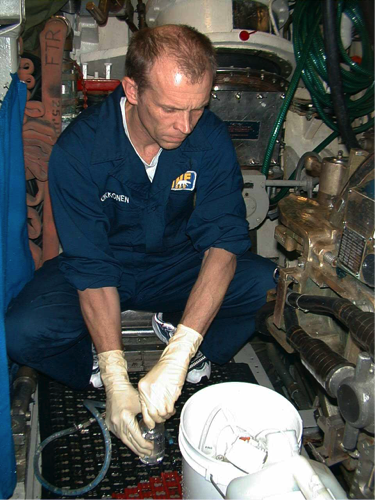
Bathymetry is measured using the submarine's fathometer. SCICEX data contributed to the International Bathymetric Chart of the Arctic Ocean (IBCAO) and led to first-order changes in the mapped positions and depths of major bathymetric features. Knowledge of seafloor topographic features is important for studies of Arctic Ocean circulation, seafloor volcanism, and hydrothermal circulation, and has informed scientific ocean drilling. The SCICEX dedicated science missions systematically mapped portions of several major topographic provinces—Gakkel Ridge, Lomonosov Ridge, and Chukchi Borderland—that have been inaccessible to icebreakers because of perennial sea-ice cover (Edwards and Coakley, 2003).
Ice draft measurements are collected using the submarine's upward looking sonar. By comparing ice draft data collected by SCICEX with previously published data, scientists established that sea ice thinned significantly within the areas where data were collected between 1958 and 1976 and in the 1990s (Rothrock et al., 2008).
Ocean nutrient data are acquired using through-hull water sampling. These data show that the rate of carbon dioxide (CO2) uptake by the Arctic Ocean is twice the average for the global ocean, leading to acidification of the Arctic Ocean (SCICEX Science Advisory Committee, 2010). Estimates of chlorophyll and oxygen reflect the response of Arctic productivity to decreased sea ice extent during summer. SCICEX observations also contribute to a better understanding of freshwater flows, the determination of biochemical conditions such as the levels of nutrients and organic matter at the end of winter, and detection and quantification of the exchange of water between the peripheral shelves and the deep basins.

SCICEX has collected hundreds of measurements by CTD instruments mounted on the sail of the submarine or cast when the submarine surfaced, and from expendable CTDs (XCTDs) launched while the submarine is at depth. Hydrographic data provide definitive, synoptic evidence of upper ocean circulation pathways, and evidence of warming and penetration of Atlantic water as it propagates along basin peripheries and ridges. As the SCICEX data archive has grown, it has played a greater role in climate and modeling studies to validate model results of temperature and salinity distributions. These data have been used to validate numerical model results of temperature and salinity distributions (Karcher et al, 2003), and to evaluate the dynamical implications of mixing parameterization in Arctic regional models (Zhang and Steele, 2007).
In 1998, due in part to a drastic reduction in the size of the nuclear submarine fleet, the Navy announced that they would no longer facilitate the dedicated scientific missions following the scheduled 1999 cruise. Rather than let the program die out, the Navy worked with research funders and the scientific community to come up with a new "bag of tricks" for a modified approach that has been employed since with support from the USN, ONR, and NSF (SCICEX SAC, 2010).
In the new phase of SCICEX, time is set aside for Navy personnel, instead of civilian scientists, to collect unclassified scientific data during otherwise classified submarine exercises. These Science Accommodation Missions (SAMs), as they have been named, are facilitated by the Navy's Arctic Submarine Laboratory.
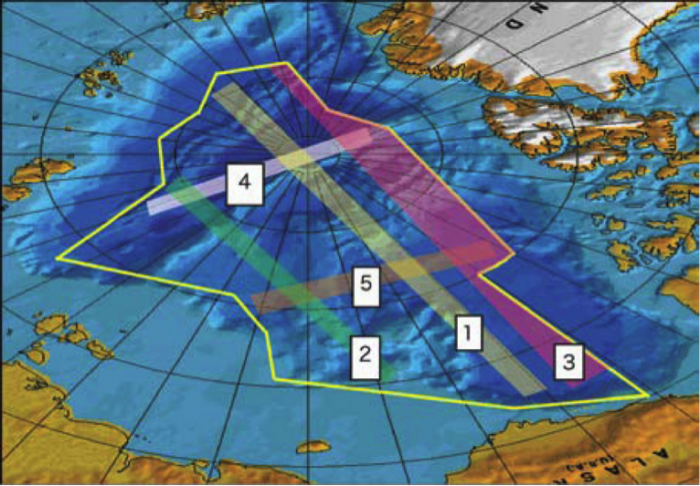
Data collection during a SCICEX SAM is restricted to a certain area of the Arctic Ocean that the Navy has approved for declassification and release of data. As part of the modified approach, scientists have created recommended corridors for data acquisition within this approved area (Figure 4). As of 2014, there have been 13 missions, 6 of which were dedicated and 7 of which were SAMs. More SAMs are in plans for the future. In 2009, the National Snow and Ice Data Center (NSIDC) became the SCICEX data manager and host of the SCICEX website, providing a comprehensive archive and information hub for the program. Much of the data from the historic dedicated missions are available, while processing of some of the newest SAM data is ongoing (Figure 5). On the website, you can register for data announcements so that you are notified when new data are released.
Today, SCICEX and its bag of tricks continue to flourish with SCICEX data available from 1999 through 2014 via the SCICEX website and more to come in 2016.
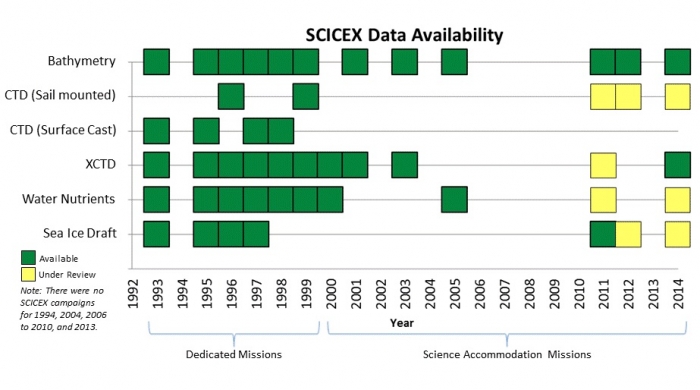
More information is available on the SCICEX web site. Or, contact Ann Windnagel (ann.windnagel [at] nsidc.org ) or Jackie Richter-Menge (Jacqueline.A.Richter-Menge [at] usace.army.mil).
Acknowledgements
We would like to thank the USN, the USN Arctic Submarine Laboratory, ONR, the U.S. Arctic Research Commission, and NSF for their continued support for SCICEX.
References
Edwards, M.H. and B.J. Coakley. 2003. SCICEX Investigations of the Arctic Ocean System. Chemie der Erde - Geochemistry 63(4): 281-328.
Karcher, M.L., R. Gerdes, F. Kauker, and C. Koeberle. 2003. Arctic warming: Evolution and Spreading of the 1990s Warm Event in the Nordic Sea and the Arctic Ocean. Journal of Geophysical Research 108(C2), 3034, doi:10.1029/2001JC001265.
Rothrock, D. A., D. B. Percival, and M. Wensnahan. 2008. The Decline in Arctic Sea-ice Thickness: Separating the Spatial, Annual, and Interannual Variability in a Quarter Century of Submarine Data. Journal of Geophysical Research 113, C05003, doi:1029/2007JC004252.
SCICEX Science Advisory Committee. 2010. SCICEX Phase II Science Plan: Part 1: Technical Guidance for Planning Science Accommodation Missions. U.S. Arctic Research Commission, Arlington, VA, 76 pp.
Zhang, J., and M. Steele. 2007. Effect of Vertical Mixing on the Atlantic Water Layer Circulation in the Arctic Ocean. Journal of Geophysical Research 112, C04S04, doi:10.1029/2006JC003732.
A Labor of Love Brings Together Civilian Scientists and the U.S. Navy
By: Ann Windnagel, National Snow and Ice Data Center

The Submarine Arctic Science Program (SCICEX) is a collaboration among the U.S. Navy, national research agencies, and the research community to use nuclear-powered submarines for scientific studies of the Arctic Ocean. Bringing the program to fruition was no small feat. It took a persistent retired Navy Captain, George Newton, over a decade of work, plus a little bit of good timing, to bridge the gap between an open and flexible scientific community and an organization like the Navy with traditions and strict operating procedures. "It is one of those things that emerges from being active in a particular area and seeing an opportunity and being able to exploit it successfully," said Newton in an April 2013 interview.
In the early 1980's, newly retired Captain Newton had an innovative idea that Navy submarines could be used to collect data about the Arctic Ocean for scientific analysis. "The advantage to the Navy," Newton said, "would be maintaining a level of proficiency in an ocean that was misunderstood or not understood at all; and, at the same time, if it was a dedicated science cruise, you would be able to give science the additional information it was seeking in a more comprehensive, broader form." This would benefit both the military and the civilian science community. After retiring from the Navy, Newton began working for a consulting firm that wanted to establish business in the Arctic. Through this position, he was able to pitch his idea to both civilian scientists and Navy personnel; and in the late 1980's, it started gaining traction.
In 1988, Newton became an advisor to the U.S. Arctic Research Commission. The position afforded him the opportunity to meet Dr. Peter McRoy, a professor at the University of Alaska Fairbanks. McRoy and Newton created a water sampling procedure and persuaded the Navy to utilize it during a classified mission to the Arctic in early 1989. The water samples were collected by Navy personnel, frozen for transport, and brought to Halifax, Nova Scotia. The samples were handed off to one of Newton's team members for repackaging and shipping to Alaska. However, the samples did not reach their destination before melting because, in March 1989, the Exxon Valdez oil spill occurred off the coast of Alaska and disrupted shipping in that area. Even though the samples melted, the test did show that samples could be collected from the submarine and then delivered to a civilian scientist. However, Newton had his eye set on a much larger vision for the project, where civilian scientists could participate onboard the submarine.
In 1992, a number of things occurred that brought Newton's idea to a head. First, the former Soviet Union was collapsing and the Cold War was ending. Consequently, the U.S. found itself with a huge Navy with fewer missions. Second, Rear Admiral Paul Ryan became the head of the Submarine Warfare Branch. This was significant because Ryan was not only a submarine officer in position to command the resources of a nuclear submarine and her crew, he also had a PhD in Oceanography, which allowed him to see the value of using submarines to study the Arctic and how it would benefit the Navy. Finally, Newton was appointed as a member of the U.S. Arctic Research Commission by President G. H. W. Bush, which allowed Newton to assemble a science team for the mission. With that, a successful feasibility cruise was conducted in the late summer of 1993 with five civilian scientists aboard the USS Pargo where the boat surfaced 17 times to collect samples. Newton recalls, "The submarine spent 19 days under the Arctic sea ice, and for the first time ever, the science community had a synoptic view of the Arctic Ocean."
In 1994, the U.S. Navy, the Office of Naval Research, the National Science Foundation, and the U.S. Geological Survey signed a memorandum of agreement to facilitate five more missions from 1995 through 1999. Those dedicated science missions gave the research community and the Navy a wealth of new information. Today, SCICEX exists in a more simplified version by way of SCICEX Accommodation Missions or SAMs. During a SAM, no civilian scientists are aboard the submarines; instead, Navy personnel follow sampling protocols to collect data that are forwarded to the scientists. From 2000 to 2014, there have been seven SAMs, and more are being planned for the future. Although SCICEX "has proceeded with some fits and starts, starts and stops, as time has worn on," as Newton puts it, the program continues to provide valuable data about the Arctic Ocean now and into the future.
The content for this article was taken from an interview with George Newton, retired chairman of and current acting advisor to the U.S. Arctic Research Commission. For more SCICEX history, visit the SCICEX history webpage to hear the complete interview with Newton.
